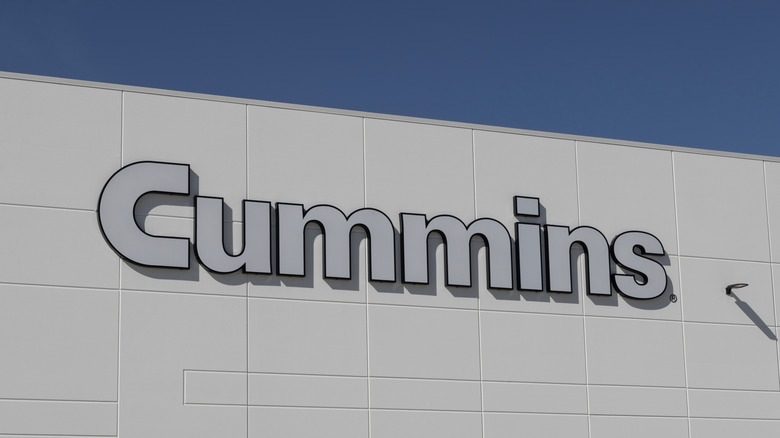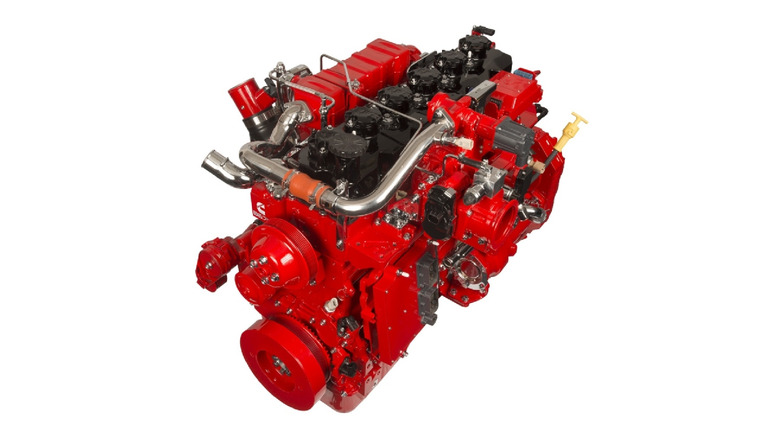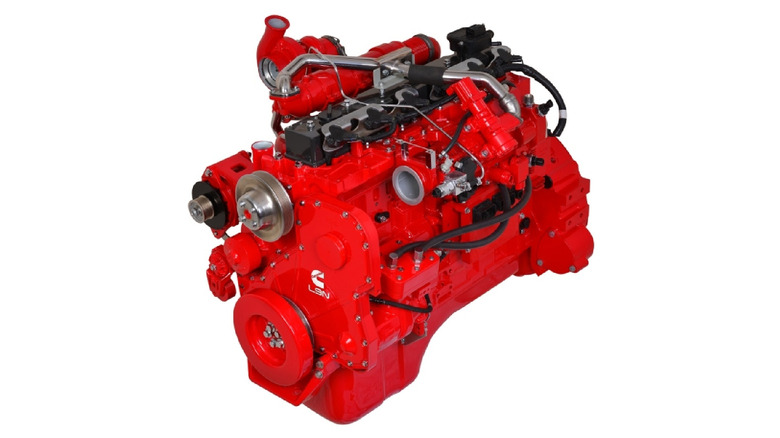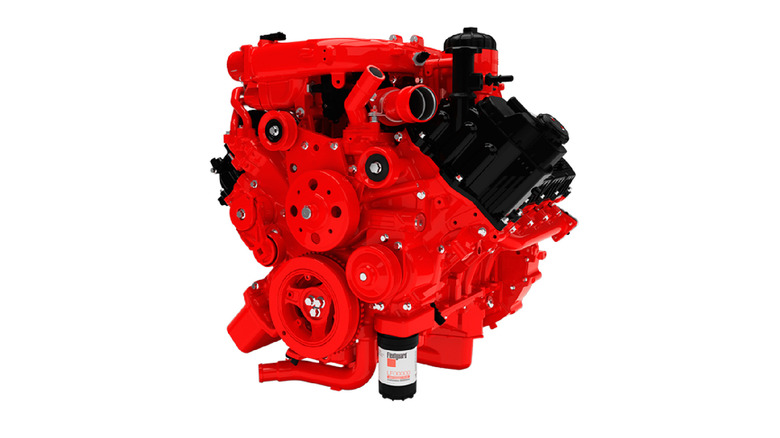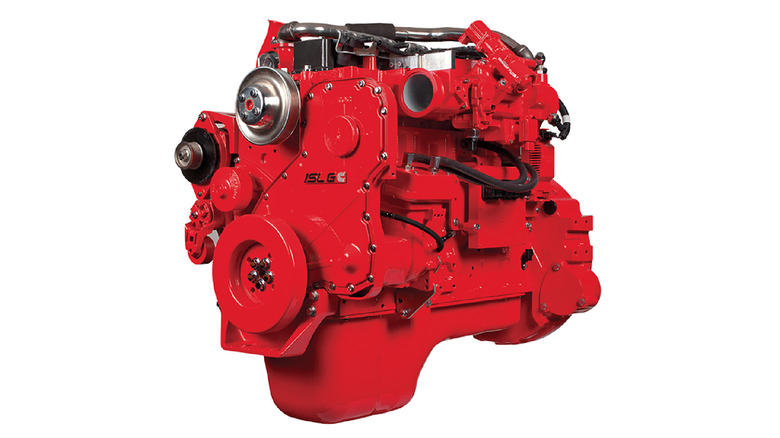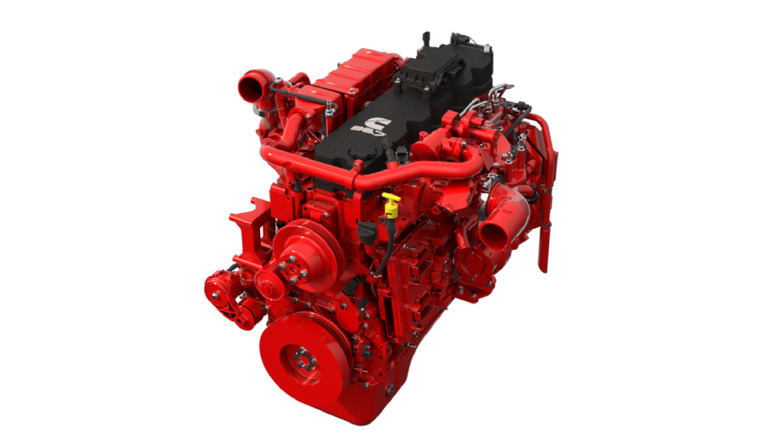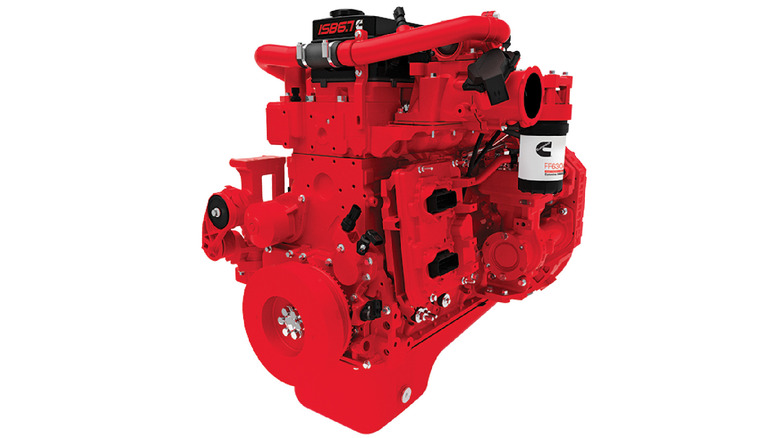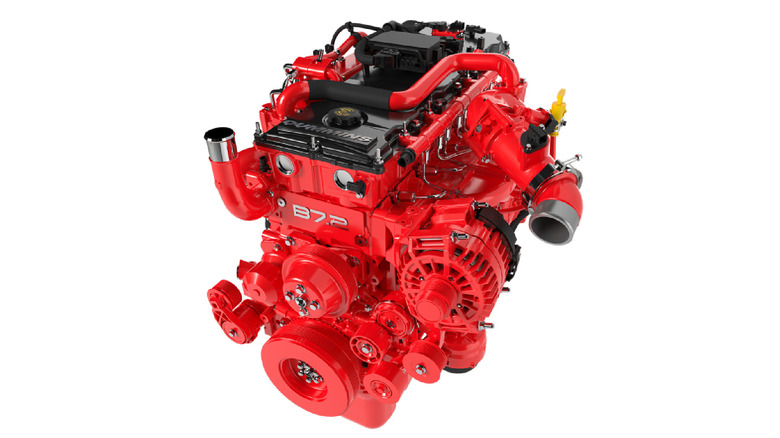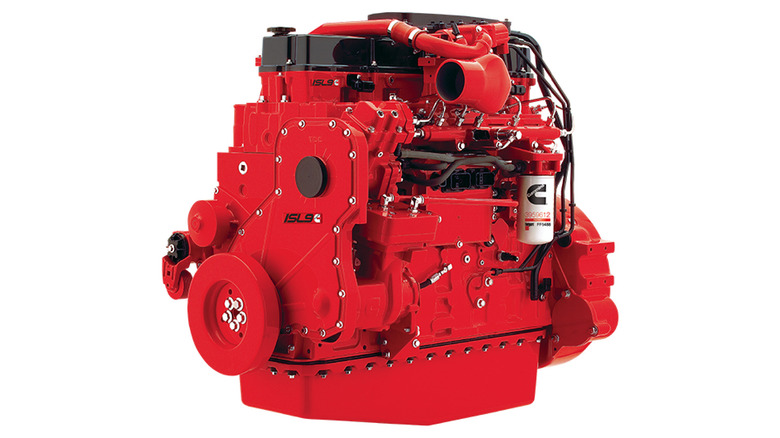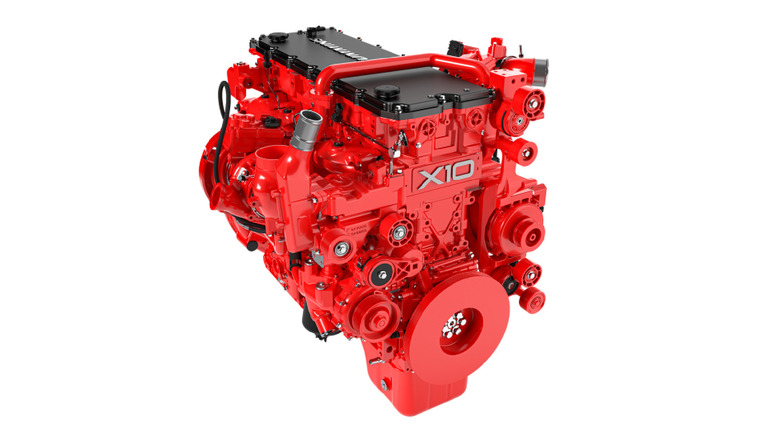Every Cummins Medium-Duty Truck Engine Released So Far, Ranked By Horsepower
In the world of semi-trucks, the engine under the hood often matters a whole lot more than the badge on the grill. In fact, most trucks across America are powered by one of just four engine manufacturers: Paccar, Mack, Detroit, and of course, Cummins. The four brands power every kind of semi-truck.
Before we tell you more though, let's go over what different vehicle classifications mean in the trucking industry. Light-duty trucks are those that have a gross weight of 8,500 pounds, and a cargo capacity of about 4,000 pounds — these fall into the Class 1 and Class 2 vehicle bands. Medium duty trucks fall between class three and class six, and have a gross weight of about 26,000 pounds. Anything over 26,000 pounds is classified as a heavy duty truck.
Within that medium-duty classification, one name has dominated the space for years, at least in terms of engines. Cummins built its first engine over 100 years ago, and today it's still making power plants, including a really unique engine that can run on hydrogenated vegetable oil. The brand also makes diesel engines for pickup trucks, and Dodge has been using Cummins diesel engines since 1989. Cummins currently offers no less than 11 medium-duty truck engines — some specialized, some general. Here are all of them.
B6.7N — 200-240 hp
Kicking things off, we have the B6.7N engine that was released for the 2018 production year, which can make up to 240 hp and 560 lb-ft of torque. The engine itself is an inline-six, just like so many of Cummins' heavy-duty, high horsepower truck engines, though this one displaces a modest 6.7 liters. It has four operating cycles, and weighs 1,150 pounds, which could make it a fantastic choice for weight-sensitive applications. The interesting bit about this unit is that it runs on natural gas, as opposed to diesel, and Cummins intends for this engine to be mainly used for shuttle buses, school buses, and by medium-duty trucks, according to their website. Notably, the unit is EPA 2018 compliant, and can be specified to only emit 0.02 grams of nitrogen oxide per brake horsepower per hour (0.02 g/bhp/hr), which is 90% less than the current EPA regulations demand.
Other notable features for the B6.7N include the addition of a new electronics control module – essentially a new computer brain for the engine – that monitors all the systems and sensors in the truck, the capability for onboard heavy-duty diagnostics, and a closed crankcase ventilation (CCV) system. What the CCV system does is, it catches all the emissions that the crankcase produces, and returns these gases to the engine for combustion, a move that directly translates to much lower emissions and in turn, better EPA and California Air Resources Board (CARB) ratings.
L9N — 250-320 hp
The next engine on our list is called the L9N, and it, just like the B6.7N that we wrote about above, is also EPA 2018 compliant — a major selling point for potential operators. It is an 8.9-liter inline-six unit that can produce between 250 and 320 hp, alongside up to 1,000 lb-ft of torque. According to Cummins, this engine is intended for use in transit and medium-duty truck applications, among others. It is also a natural gas engine, and can wholly run on compressed natural gas (CNG), liquefied natural gas (LNG), as well as renewable natural gas (RNG), without sacrificing any performance. According to its specification sheet, biomethane is also one of the fuel options for the L9N.
It also comes with the same new electronic control module as the B6.7M from earlier, meaning that this engine is also fully capable of monitoring itself and detecting any issues via its onboard diagnostics management system. The higher horsepower and performance does come with a tradeoff though, and that tradeoff is the 1,625-pound dry weight of this engine, as well as a slightly worse warranty. While the B6.7N gets a two-year unlimited warranty, only transit and shuttle bus applications get the unlimited warranty with this engine. If customers use the L9N in medium duty trucks, then their warranty is two years but limited to 250,000 miles. Thus, operators need to think about whether they'd rather have more grunt, or better warranty for their engine.
ISV 5.0 — 200-275 hp
The ISV5.0 is the first engine on our list mainly intended for use (according to Cummins) in medium-duty trucks, though it's apparently also great for pickup trucks and school buses. It is a 5-liter V8 unit that weighs a paltry 804 pounds, producing between 200 and 275 hp, alongside 560 lb-ft of torque. A fair bit of this low weight can be attributed to the ISV 5.0 using a compacted graphite iron block, which reduces weight while maintaining durability — all of the benefits of cast iron without any of the bulk. The ISV 5.0 is also quite an old power plant too, having gone into production toward the end of 2014, but this fact also means that spares will be easier to source, and mechanics will have experience working on these engines.
In addition, this engine also comes with what was at the time a state-of-the-art aftertreatment system made by Cummins Emission Solutions (CES), that included all the bells and whistles — namely a full diesel particulate filter and selective catalyst reduction, alongside an exhaust gas recirculation system. Today these features are pretty much standard on all semi-truck aftertreatment systems, thanks to ever more stringent environmental concerns. Other notable features on the ISV 5.0 include the fact that it is EPA 2013 compliant, relatively quiet operation, a shiny new high-pressure common rail fuel injection system that can pump out fuel at 29,000 psi, and up to a 40% better fuel economy than a comparable gasoline-powered V8 engine.
ISL-G Near Zero — 250-320 hp
This next engine is rather interesting, because it was Cummins' attempt at meeting the then-new "Near Zero" emissions standard that had just been introduced. The ISL-G was initially designed to be a full replacement for the L10 engine, and because of the way that Cummins designed it, the various versions of this ISL engine have been in production for more than two decades. It was among the first engines that Cummins would make in collaboration with a company called Westport Innovations, who were considered to be America's leading natural-gas engine manufacturer at the time.
In terms of specifications, the Cummins ISL-G is an 8.9-liter inline-six engine that can make a maximum of 320 hp and 1,000 lb-ft of torque. It is a forced-induction unit that uses a turbocharger, and weighs 1,625 pounds, making it perfectly suited for various medium-duty truck applications. This engine can be powered by any of the three major forms of natural gas (CNG, LNG, and RNG), as well as methane fuel with a number of 75 or higher. It has a three-way catalytic reduction aftertreatment system, as has been standard in the industry for a long time, and a crankcase ventilation system. Notably, at the time the ISL-G Near Zero was launched, it had the highest power-to-weight ratio of any engine in its class, which would have undoubtedly been a major selling point.
Cummins ISL-G — 250-320 hp
The ISL-G, as you may have guessed from the name, is the "base version" so to speak, that the ISL-G Near Zero was built on. It is structurally very similar, but slightly different in terms of performance output. First, let's cover the similarities: both the ISL-G and the Near Zero are alternative fuel engines, because they both were designed to work with the three major forms of natural gas, namely, compressed natural gas, liquefied natural gas, and renewable natural gas. Both of the engines displace 8.9 liters, and are inline-six cylinder units, capable of producing up to 320 hp.
Also, both engines have five versions making 250, 260, 280, 300, and 210 hp, with peak torque available at 1,300 RPM. However, this is where the difference between the engines comes in — where the Near Zero has a torque range of 730 to 1,000 lb-ft, the ISL-G has a wider range of 660 to 1,100 lb-ft. It might not sound like much, but when you look at the numbers, that is about 10 percent more on the upper end — which could very much make a difference in day to day use for operators. Other interesting things to note about the ISL-G are that it has an oxygen-free exhaust pipeline, a water-cooled turbocharger, and a self-tensioning belt-system for most of its alternators, that also help keep the water pump and engine fan running smoothly.
B6.7 Medium Duty version — 200-325 hp
This engine, called the B6.7 Medium Duty, is a decent upgrade from the B6.7N that was the first item on our list. Though the two undoubtedly are very closely interrelated, this newer version is, first and foremost, EPA 2021 compliant versus the B6.7N that is only EPA 2018 compliant. As a result, this power plant will be a fair bit more future proof than the older engine, and it can also make a lot more peak horsepower and torque too. Specifically, where the B6.7N could make up to 240 hp and 560 lb-ft of torque, this new B6.7 Medium Duty ups those numbers to 325 hp and 750 lb-ft respectively.
The new Medium Duty B6.7 also has a lot of tech packed into it, including a variable geometry turbocharger (VGT), and is also telematic-diagnostic capable. However, it's worth noting that we're not sure whether third-party diagnostic tools will work out of the box; however, Cummins' "Connected Technologies" software is fully supported. This engine also has an all-new aftertreatment system that has a "single box" housing, as Cummins calls it, that is claimed to have a footprint that is 70% smaller and 30% lighter than traditional aftertreatment systems. The maintenance intervals for the B6.7 Medium Duty are also very impressive for an engine of this caliber, with intervals of 30,000 miles for the oil filters, 60,000 miles for the fuel filters, and a whopping 300,000 miles for the DEF filter.
ISB 6.7 — 200-325 hp
Next up, we have yet another version of the B6.7 platform called the ISB6.7. This one is the grandfather of them all, and as such, is slightly on the older side. Released in 2007, this 6.7-liter engine has a rather wide horsepower range of between 200 and 325 hp, and can produce up to 750 lb-ft of peak torque, which is available from as low as 1800 RPM — meaning that operators will have plenty of grunt ready to go in low range. Also, only the highest 325 hp variant has peak torque from 1,800 RPM — all of the other seven engine variants have their peak torque from 1,600 RPM. This, coupled with the low engine weight of just 1,150 pounds, means that for use-cases where weight or terrain gradient is an issue, the ISB6.7 will shine.
The total system weight for the power plant — the weight of the engine and the aftertreatment system combined — is 1,357 pounds, which is still not too bad considering that this system can output up to 325 hp. Other plus points for the ISB 6.7 are its two-year/unlimited miles warranty that includes parts and labor on both the engine and aftertreatment system, its high-pressure common rail fuel injection system, EPA 2013 and greenhouse gas (GHG) 2014 compliance, and what was at the time, the best fuel economy of all the engines in the class.
B 7.2 — 260-340 hp
When initially being covered in the media, many people wondered if the Cummins B7.2 engine was even real – but that's because images circulating were pointing to this 7.2-liter beast going to power a RAM pickup truck. While that probably won't happen anytime soon, the Cummins 7.2 diesel certainly is real, but will power medium-duty semi rigs, as opposed to a RAM pickup, however desirable that may be. This behemoth is a 7.2-liter inline-six unit that churns out anywhere from 260 to 340 hp, and between 650 and 1,000 lb-ft of torque.
It is one of the newest engines that Cummins has made, and will have a new aftertreatment system, 48-volt alternator, and will have a stop-and-start feature— and it's no small task to make such a behemoth stop-and-start capability. The engine has eight different versions, each making different peak horsepower: a 240 hp one, a 260 hp one, a 280 hp one, and two versions each for 300 hp, 320 hp and 340 hp. It is worth noting that the Cummins B7.2 is not currently on the market, and the company says that it will hit North American roads some time in 2027.
L9 — 260-380 hp
Next up, we have the legendary Cummins L9 that happens to be very similar to the natural-gas powered L9N that we covered at the beginning of our list. This engine is an inline-six unit that produces between 260 to 380 hp, and between 860 to 1,250 lb-ft of torque. The L9 is also fully EPA 2024 compliant, making it potentially the most future-proof engine on this list, with the exception of the Cummins X10 that we will talk about later — though the X10 isn't released yet, so the L9 still holds the title of being the most compliant engine in Cummins' medium-duty lineup.
Cummins has made several improvements to the L9 that are aimed at improving its lifespan and repairability, the most notable of which are longer maintenance intervals and replaceable cylinder liners. The L9 can also get over-the-air (OTA) software and firmware updates, comes with Cummins' Connected Technologies diagnostics suite, as well as the company's proprietary remote-help tool, called "Guidanz." It also has a single-module aftertreatment system that is probably very similar to the one on the B6.7 Medium Duty engine that you read about above. All of this, coupled with the L9's 1,695 pound weight mean that this is one big, all-inclusive package that will likely meet the needs of a very wide variety of customers, from vocational use, to transport, to trucking, and everything in between.
ISL-9 — 345-390 hp
The L9 engine that we just covered above is actually the successor to this unit, the Cummins ISL-9. While the L9 might have all the new bells and whistles and certifications, the ISL-9 is no slouch — still a very capable engine that can and should still be under consideration for medium-duty truck use. While old, this 8.9-liter inline-six engine makes between 345 and 380 hp and between 1,150 and 1,300 lb-ft of torque — both of which are rather tight ranges to choose between, but manageable. There are only three different models offered on the ISL-9: 345 hp, 370 hp, and the top-of-the-line 380 hp, which is a far cry from the eight different models that the B7.2 is going to release with.
The ISL-9 comes with Cummins XPI fuel system, a variable geometry turbocharger, a decent aftertreatment system with particulate filters, and an actively-cooled exhaust gas recirculation system. That last bit is really important, as it ensured that the gases that were returned from the exhaust to the engine are not piping hot, as that would put undue stress on the engine cooling system, which in turn could very quickly result in performance issues from thermal throttling. All in all, it's an unremarkable engine by today's standards, but is tried, tested, and true, and that's what most truckers would want from their power units to begin with.
X10 — 320-450 hp
And finally, we have this one — the Cummins X10, designed to blow everything else on this list out of the water. According to Cummins, the X15 will use parts from its flagship X15 engine that is designed for heavy-duty use, which means that the X10 will likely be among the toughest Cummins engines ever built. While the full specifications have not been released yet, what we do know is that the X10 will output between 320 and 450 hp, and between 1,000 and 1,650 lb-ft of torque — ranges that will definitely have an engine variant to suit anyone's needs.
In addition, the X10 will also be fully compatible out of the box with the Cummins HELM platform that would let customers choose between different kinds of fuel — this would be an insane advancement in the world of long-distance trucking. Finally, the X10 will be EPA 2027 compliant, so when it does eventually hit the road, it will be the most advanced and future-proof Cummins medium-duty engine in the market. Also, Cummins' website says that the X10 will be available in most major markets, including Asia, India, Africa, North America, Latin America, Europe, and the Middle East. And that's it — that wraps up all the eleven engines that Cummins currently supports or sells in the medium-duty truck segment — if you didn't know, now you know.
